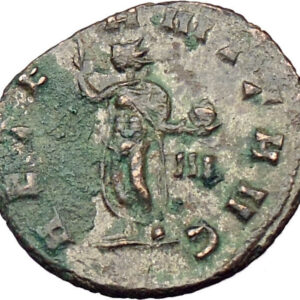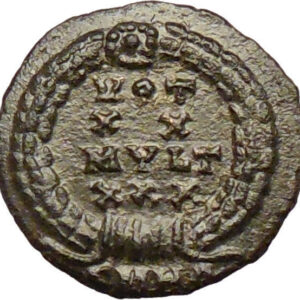|
Valentinian I – Roman Emperor: 364-375 A.D.
‘Last great western emperor’
Bronze AE3 17mm
(2.70 grams), Thessalonica mint, struck 364-367 A.D.
Reference: RIC IX 17a1, A
D N VALENTINIANVS P F AVG, Pearl diademed, draped and cuirassed bust right.
RESTITVTOR REIP / TESB, Valentinian standing facing, head right, holding labarum and Victory on globe.
You are bidding on the exact item pictured, provided with a Certificate of Authenticity and Lifetime Guarantee of Authenticity.
 The labarum was a vexillum (military standard) that displayed the “Chi-Rho” symbol ☧, a christogram formed from the first two Greek letters of the word “Christ” (Greek: ΧΡΙΣΤΟΣ, or Χριστός) – Chi (χ) and Rho (ρ). It was first used by the Roman emperor Constantine I. Since the vexillum consisted of a flag suspended from the crossbar of a cross, it was ideally suited to symbolize the crucifixion of Christ. The labarum was a vexillum (military standard) that displayed the “Chi-Rho” symbol ☧, a christogram formed from the first two Greek letters of the word “Christ” (Greek: ΧΡΙΣΤΟΣ, or Χριστός) – Chi (χ) and Rho (ρ). It was first used by the Roman emperor Constantine I. Since the vexillum consisted of a flag suspended from the crossbar of a cross, it was ideally suited to symbolize the crucifixion of Christ.
Ancient sources draw an unambiguous distinction between the two terms “labarum” and “Chi-Rho”, even though later usage sometimes regards the two as synonyms. The name labarum was applied both to the original standard used by Constantine the Great and to the many standards produced in imitation of it in the Late Antique world, and subsequently.

The Chi Rho is one of the earliest forms of christogram, and is used by some Christians. It is formed by superimposing the first two (capital) letters chi and rho (ΧΡ) of the Greek word “ΧΡΙΣΤΟΣ” = KRistos = Christ in such a way to produce the monogram. Although not technically a Christian cross, the Chi-Rho invokes the authority of Jesus, as well as symbolising his status as the Christ.
The Chi-Rho symbol was also used by pagan Greek scribes to mark, in the margin, a particularly valuable or relevant passage; the combined letters Chi and Rho standing for chrēston, meaning “good.” Some coins of Ptolemy III Euergetes (r. 246-222 BC) were marked with a Chi-Rho.
The Chi-Rho symbol was used by the Roman emperor Constantine I (r. 306-337) as part of a military standard (vexillum), Constantine’s standard was known as the Labarum. Early symbols similar to the Chi Rho were the Staurogram (_I_193_2.jpg/20px-Christliche_Symbolik_(Menzel)_I_193_2.jpg) ) and the IX monogram ( ) and the IX monogram (_I_193_4.jpg/20px-Christliche_Symbolik_(Menzel)_I_193_4.jpg) ). ).
Valentinian I – Augustus: 364-375 A.D.
| 364-367 A.D. – Sole Reign | 367-375 A.D. Senior Augustus with Gratian |
Ruling in the East: Valens (364-378 A.D.) & Procopius (365-366 A.D.)
| Brother of Valens | Husband of Severa and Justina | Father (by Severa) of Gratian and (by Justina) of Valentinian II and Galla | Father-in-law of Theodosius I and Constantia (daughter of Constantius II) | Grandfather of Galla Placidia | Great-grandfather of Valentinian III and Honoria |
 Flavius Valentinianus, known in English as Valentinian I, (321 – November 17, 375) was Roman Emperor from 364 until his death. Valentinian is often referred to as the “last great western emperor”. Both he and his brother Emperor Valens were born at Cibalae (modern days Vinkovci, Croatia), in Pannonia, the sons of a successful general, Gratian the Elder. Flavius Valentinianus, known in English as Valentinian I, (321 – November 17, 375) was Roman Emperor from 364 until his death. Valentinian is often referred to as the “last great western emperor”. Both he and his brother Emperor Valens were born at Cibalae (modern days Vinkovci, Croatia), in Pannonia, the sons of a successful general, Gratian the Elder.
Life
He had been an officer who served under the emperors Julian and Jovian, and had risen high in the imperial service. Of robust frame and distinguished appearance, he possessed great courage and military capacity. After the death of Jovian, he was chosen emperor in his forty-third year by the officers of the army at Nicaea in Bithynia on February 26, 364, and shortly afterwards named his brother Valens colleague with him in the empire.
The two brothers, after passing through the chief cities of the neighbouring district, arranged the partition of the empire at Naissus (Nissa) in Upper Moesia. As Western Roman Emperor, Valentinian took Italia, Illyricum, Hispania, the Gauls, Britain and Africa, leaving to Eastern Roman Emperor Valens the eastern half of the Balkan peninsula, Greece, Aegyptus, Syria and Asia Minor as far as Persia. They were immediately confronted by the revolt of Procopius, a relative of the deceased Julian. Valens defeated his army at Thyatira in Lydia in 366, and Procopius was executed shortly afterwards.
During the short reign of Valentinian there were wars in Africa, in Germany, and in Britain, and Rome came into collision with barbarian peoples, specifically the Burgundians and the Saxons.
Valentinian’s chief work was guarding the frontiers and establishing military positions. Milan was at first his headquarters for settling the affairs of northern Italy. The following year (365) Valentinian was at Paris, and then at Reims, to direct the operations of his generals against the Alamanni. These people, defeated at Scarpona (Charpeigne) and Catelauni (Châlons-en-Champagne) by Jovinus, were driven back to the German bank of the Rhine, and checked for a while by a chain of military posts and fortresses. At the close of 367, however, they suddenly crossed the Rhine, attacked Moguntiacum (Mainz) and plundered the city. Valentinian attacked them at Solicinium (Sulz am Neckar, in the Neckar valley, or Schwetzingen) with a large army, and defeated them with great slaughter. But his own losses were so considerable that Valentinian abandoned the idea of following up his success.
Later, in 371, Valentinian made peace with their king, Macrian, who from that time remained a true friend of the Romans. The next three years he spent at Trier, which he chiefly made his headquarters, organizing the defence of the Rhine frontier, and personally superintending the construction of numerous forts.
During his reign the coasts of Gaul were harassed by the Saxon pirates, with whom the Picts and Scots of northern Britain joined hands, and ravaged the island from the Antonine Wall to the shores of Kent. In 368 Count Theodosius was sent to drive back the invaders; in this he was completely successful, and established a new British province, called Valentia in honour of the emperor.
In Africa, Firmus raised the standard of revolt, being joined by the provincials, who had been rendered desperate by the cruelty and extortions of Comes Romanus, the military governor. The services of Theodosius were again requisitioned. He landed in Africa with a small band of veterans, and Firmus, to avoid being taken prisoner, committed suicide.
In 374, the Quadi, a Germanic tribe in what is now Moravia and Slovakia, resenting the erection of Roman forts to the north of the Danube in what they considered to be their own territory, and further exasperated by the treacherous murder of their king, Gabinius, crossed the river and laid waste the province of Pannonia. The emperor in April, 375 entered Illyricum with a powerful army. But during an audience to an embassy from the Quadi at Brigetio on the Danube (near today Komárno in Slovakia), Valentinian suffered a burst blood vessel in the skull while angrily yelling at the people gathered. This injury resulted in his death on November 17, 375.
Reputation
A.H.M. Jones writes that though he was “less of a boor” than his chief rival for election to the imperial throne, “he was of a violent and brutal temper, and not only uncultivated himself, but hostile to cultivated persons”, as Ammianus tells us, ‘he hated the well-dressed and educated and wealthy and well-born’. He was, however, an able soldier and a conscientious administrator, and took an interest in the welfare of the humbler classes, from which his father had risen. Unfortunately his good intentions were often frustrated by a bad choice of ministers, and an obstinate belief in their merits despite all evidence to the contrary.”[2] According to the Encyclopædia Britannica 1911, he was a founder of schools, and provided medical attendance for the poor of Rome, by appointing a physician for each of the fourteen districts of the city.
Valentinian was a Christian but permitted liberal religious freedom to all his subjects, proscribing only some forms of rituals such as particular types of sacrifices, and banning the practice of magic. Against all abuses, both civil and ecclesiastical (excepting, of course, his own excesses), Valentinian steadily set his face, even against the increasing wealth and worldliness of the clergy. His chief flaw was his temper, which at times was frightful, and showed itself in its full fierceness in the punishment of persons accused of witchcraft, some kinds of fortune-telling or magical practices.”
|





 The labarum was a vexillum (military standard) that displayed the “Chi-Rho” symbol ☧, a christogram formed from the first two Greek letters of the word “Christ” (Greek: ΧΡΙΣΤΟΣ, or Χριστός) – Chi (χ) and Rho (ρ). It was first used by the Roman emperor Constantine I. Since the vexillum consisted of a flag suspended from the crossbar of a cross, it was ideally suited to symbolize the crucifixion of Christ.
The labarum was a vexillum (military standard) that displayed the “Chi-Rho” symbol ☧, a christogram formed from the first two Greek letters of the word “Christ” (Greek: ΧΡΙΣΤΟΣ, or Χριστός) – Chi (χ) and Rho (ρ). It was first used by the Roman emperor Constantine I. Since the vexillum consisted of a flag suspended from the crossbar of a cross, it was ideally suited to symbolize the crucifixion of Christ. 
_I_193_2.jpg/20px-Christliche_Symbolik_(Menzel)_I_193_2.jpg) ) and the IX monogram (
) and the IX monogram (_I_193_4.jpg/20px-Christliche_Symbolik_(Menzel)_I_193_4.jpg) ).
). Flavius Valentinianus, known in English as Valentinian I, (321 – November 17, 375) was Roman Emperor from 364 until his death. Valentinian is often referred to as the “last great western emperor”. Both he and his brother Emperor Valens were born at Cibalae (modern days Vinkovci, Croatia), in Pannonia, the sons of a successful general, Gratian the Elder.
Flavius Valentinianus, known in English as Valentinian I, (321 – November 17, 375) was Roman Emperor from 364 until his death. Valentinian is often referred to as the “last great western emperor”. Both he and his brother Emperor Valens were born at Cibalae (modern days Vinkovci, Croatia), in Pannonia, the sons of a successful general, Gratian the Elder. 




